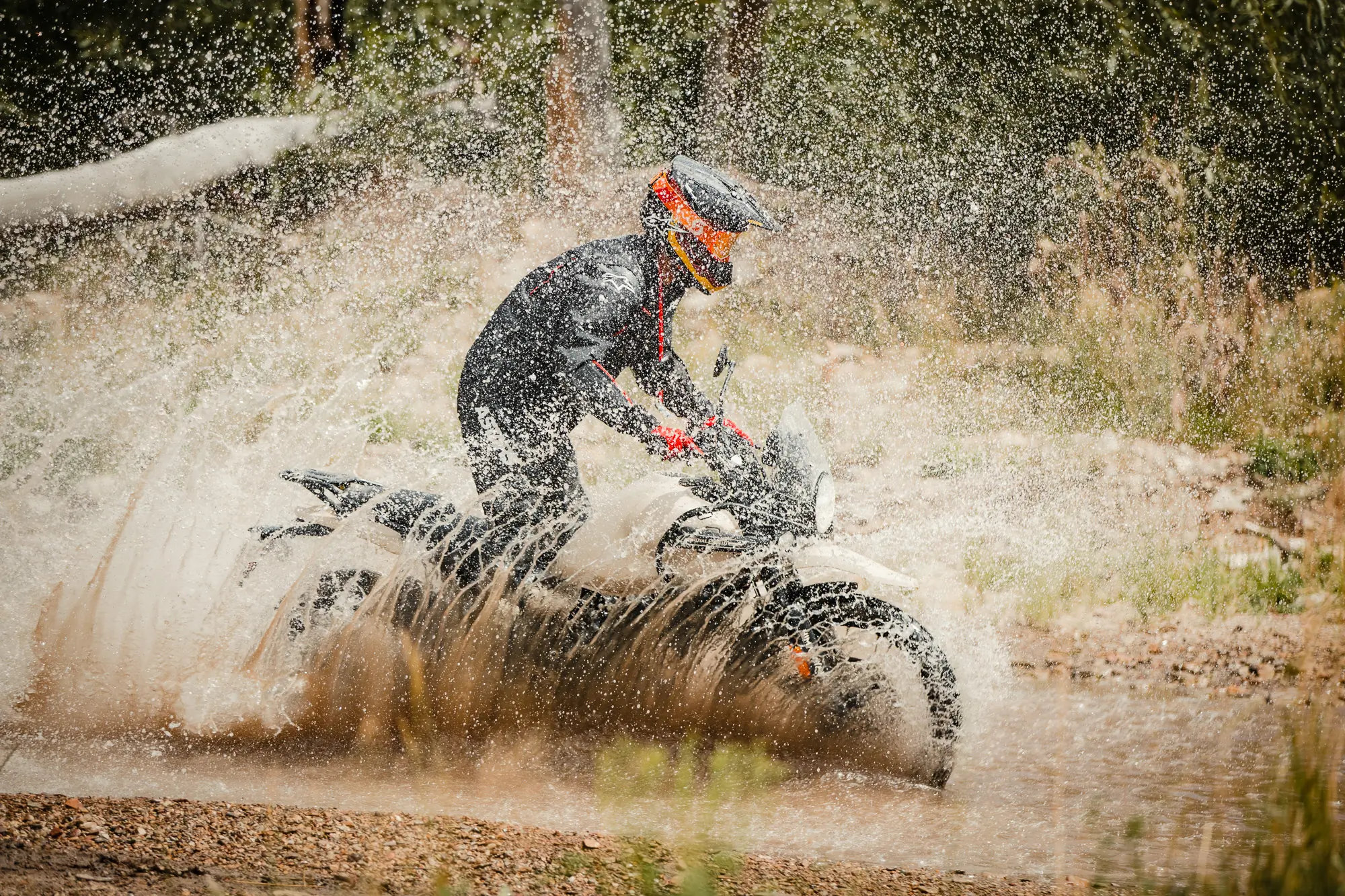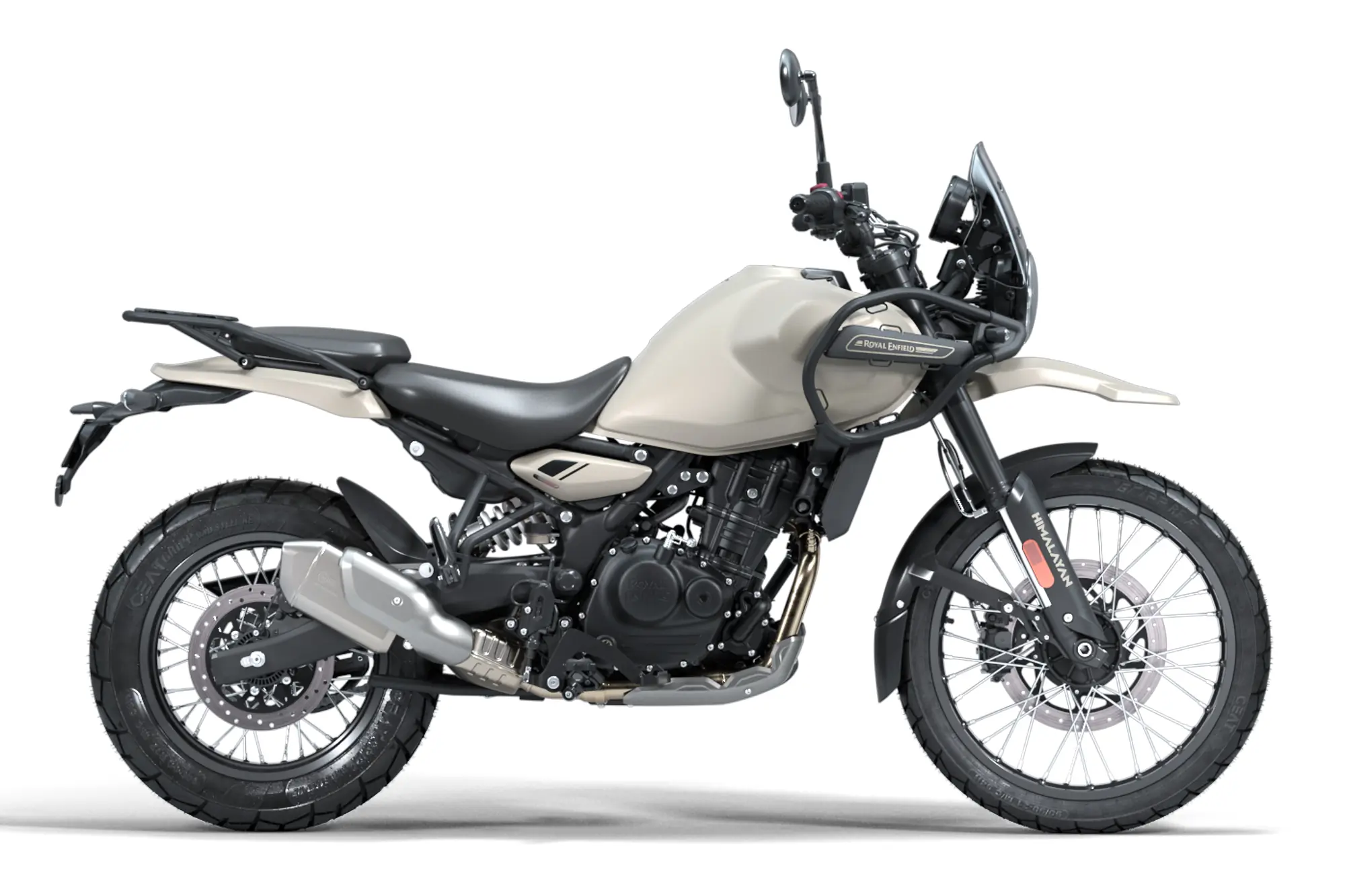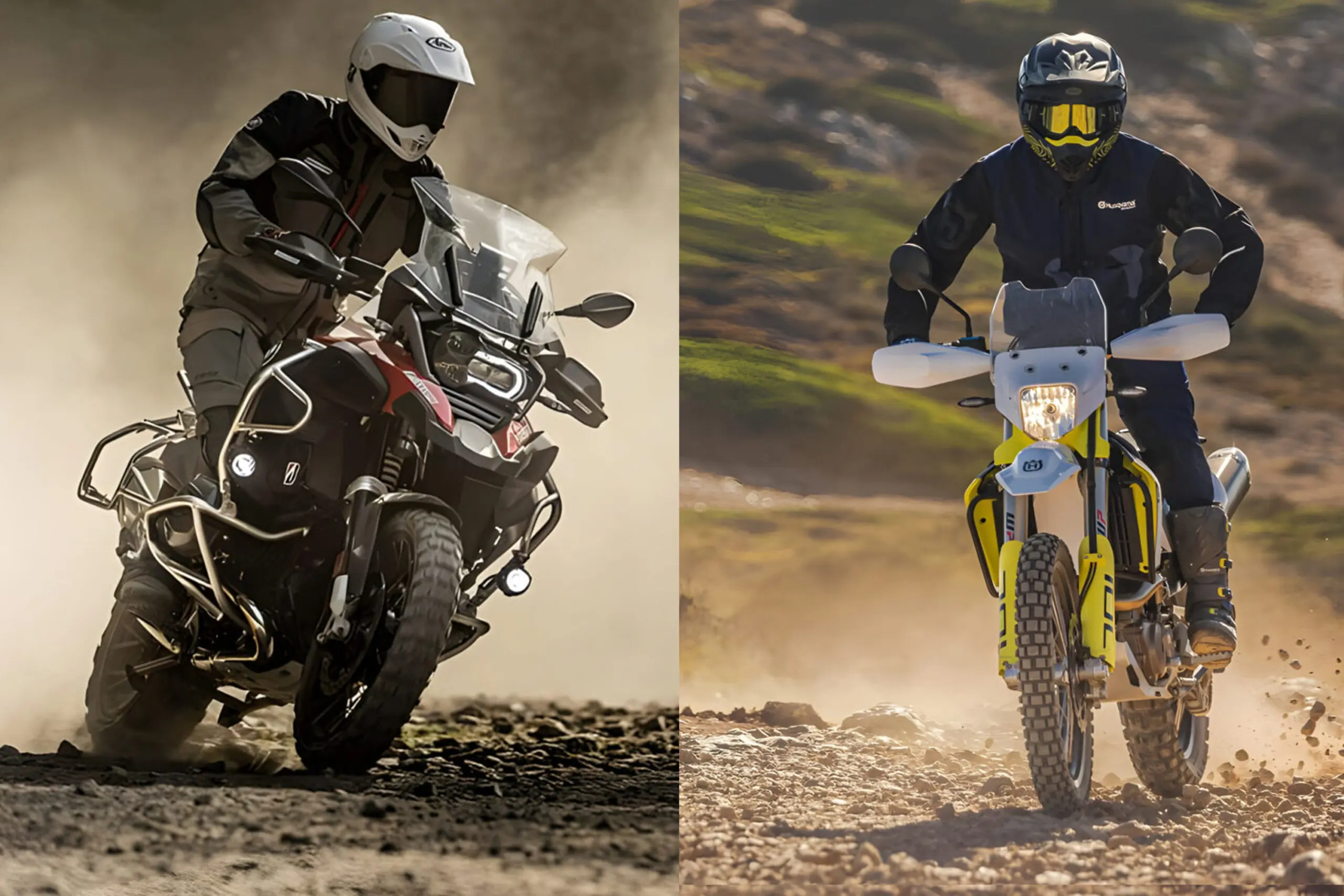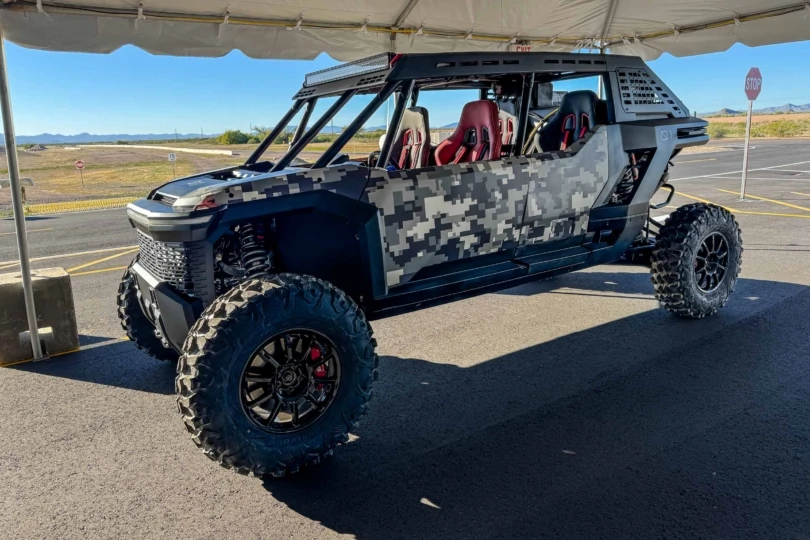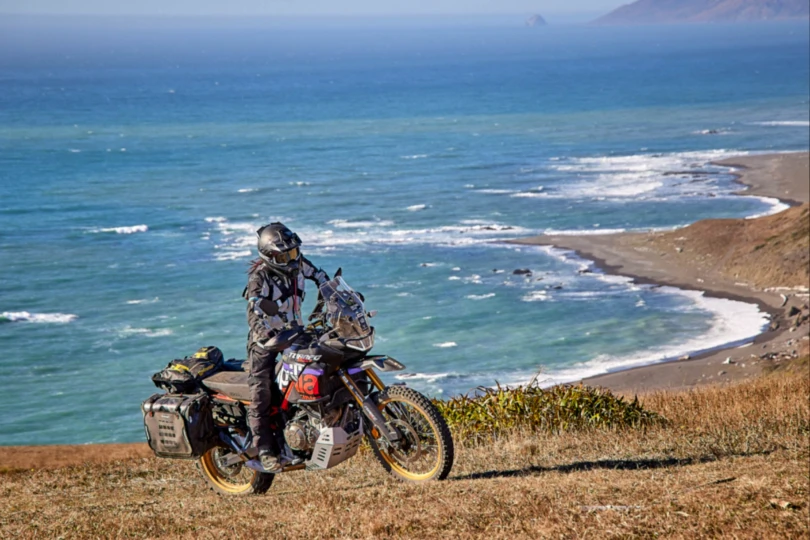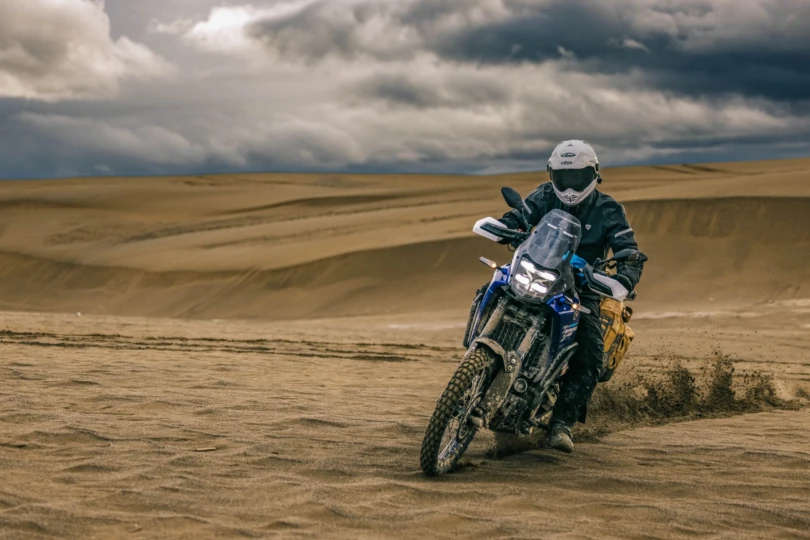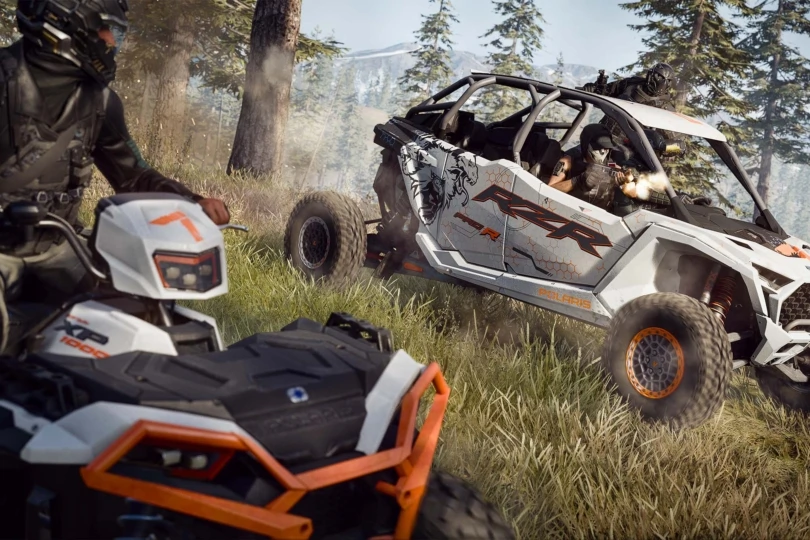Royal Enfield launched the all-new Himalayan 450 last week, and I attended the launch event in Heber City, Utah. The adventure bike has a 450cc liquid-cooled motor, inverted Showa cartridge fork, Showa shock (?!), and a fully connected TFT display, which are very significant departures from the original Himalayan.
Legacy British brand Royal Enfield, now an Indian brand, introduced the first Himalayan adventure motorcycle in 2016. I attended the launch, but I wasn’t impressed. The bike was anemic in power and suspension capability. I wrote it off as an affordable commuter motorcycle that looked hip and adventuresome.
I admit I had a similar mindset when boarding the plane to Utah for the launch of the new Himalayan. However, upon arrival and seeing the new motorcycle, I understood that it is wholly different and very important for Royal Enfield. The brand is injecting itself into the serious adventure bike market.
After a few hours of diving into the clean-sheet design and features, our group of moto journalists and influencers embarked on a 100+ mile ride that was 60% pavement and 40% dirt. We traversed everything from dry and rocky terrain to impossibly slippery clay-based mud, long climbs, descents, and full-throttle highway miles.
In short: The Royal Enfield Himalayan is a legitimate adventure motorcycle with an extraordinarily affordable price tag. At a starting MSRP of $5,799, the Himalayan costs less than half of some adventure bikes. And it clearly outperforms other middleweight dual-sport bikes in the price range. The performance characteristics are ideal for new riders, and the price lowers the barrier to entry to real adventure riding.
- Engine type: Liquid-cooled, single cylinder, DOHC, 4 valves
- Engine displacement: 452cc
- Maximum power: 39.5 horsepower @8,000 rpm
- Maximum torque: 40 Nm @5,500 rpm
- Rear suspension travel: 200mm
- Front suspension travel: 200mm
- Fuel capacity: 4.5 gals. (0.5 gallon reserve)
Pros
- Great overall performance for the price
- Very capable suspension package, both on and off road
- Good ergonomics
- Smooth motor for a single cylinder
- Crashworthy
Cons
- Slow to rev engine is sometimes limiting
- Inner front fender easily jammed by mud
- Lack of knobby tires hurts off road handling
The Royal Enfield Himalayan Spec Sheet
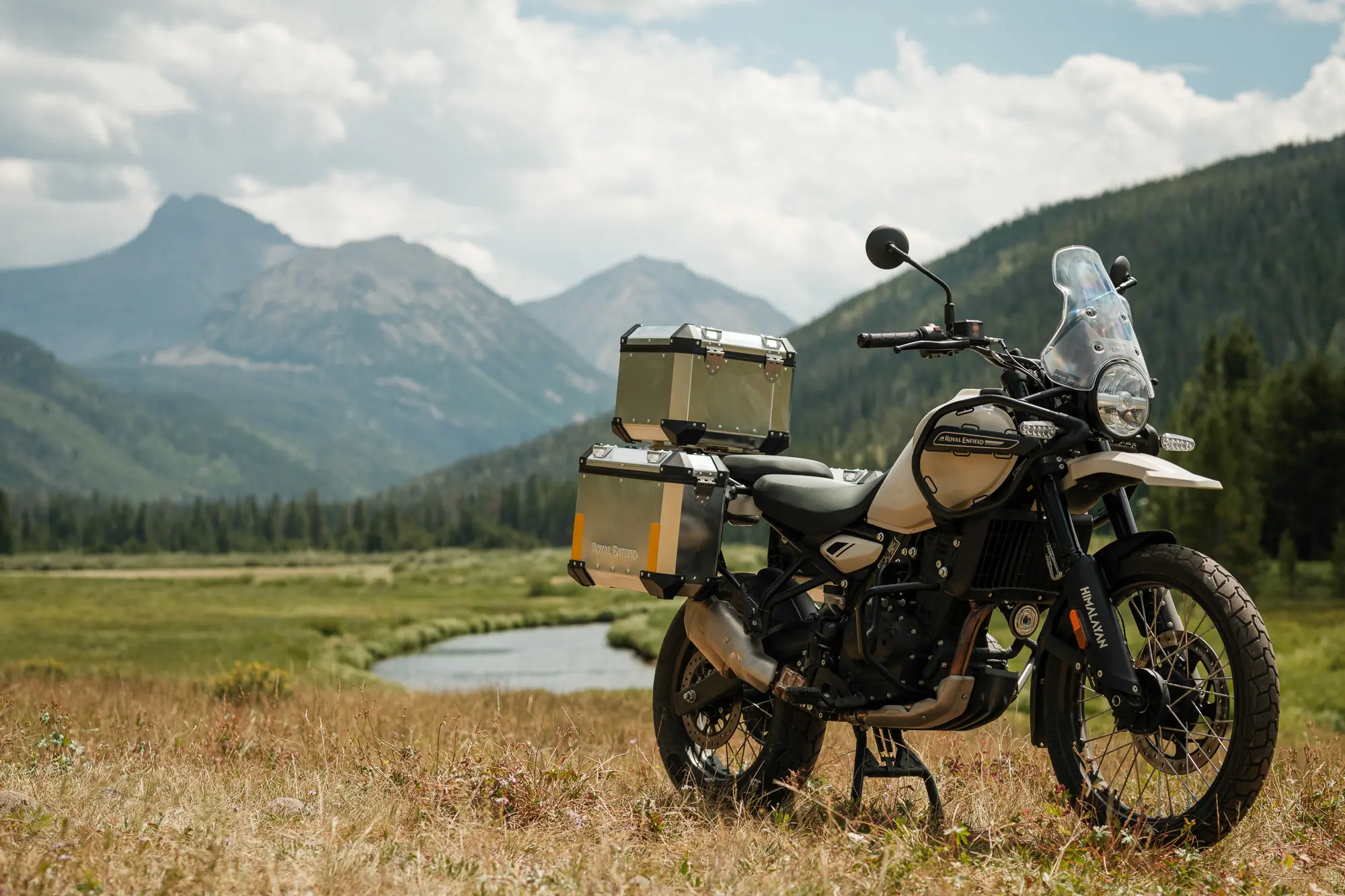
The newly developed 452cc liquid-cooled DOHC, four-valve Sherpa motor pushes a claimed 39.5 horsepower at 8,000 rpm at the crank. Royal Enfield puts the torque at 40 Nm at 5,000 rpm. It’s fuel-injected and employs a ride-by-wire throttle, and the power is modulated through a six-speed transmission. There are two ride modes: Performance and Eco.
The inverted cartridge forks and shock come from Showa, which was surprising given the price point. The 43mm fork provides 200mm of travel, while the shock delivers the same travel through a linkage. The fork doesn’t have clickers, but the shock preload is adjustable.
A dual-piston ByBre (a subsidiary of Brembo) caliper clamps a 320mm single front disc. A single-piston unit bites down on a 270mm rotor at the back. Dual-channel ABS provides safety and traction while on the binders. A couple of button presses disables the rear ABS.
A round, stylish 4-inch TFT display delivers vital information, including full-map navigation via Google Maps. It connects to smartphones and provides all the modern conveniences, including media controls.
Unfortunately, for a phone to broadcast navigation to the display, its own display must remain on. This isn’t Royal Enfield’s fault; it’s a phone limitation, but the bike does have a USB port for charging. Notably, every external lamp on the Royal Enfield Himalayan is LED.
The wheelbase is 59.5 inches, while the ground clearance is 9.1 inches. The adjustable seat can range in height from 32.5 to 33.3 inches, and Royal Enfield offers a low version. The front tire is 21″ and the rear is 17″; both tread patterns were on the street side of dual-sport. Royal Enfield lists the curb weight as 432.1 pounds. This is with all oils and 90% of the 4.5-gallon fuel tank filled (0.5-gallon reserve).
Based on these specifications, I felt the bike punched well above the price category, especially the suspension, brake, and display. Although the motor sounded promising, as usual, I was still skeptical about the all-new platform.
A Day on the Royal Enfield Himalayan 450
The planned 100+ mile route included a few highway runs and had plenty of dirt, climbing, descending, and creek crossings. It seemed ideal for a first ride aboard the new adventure bike.
On the Highway
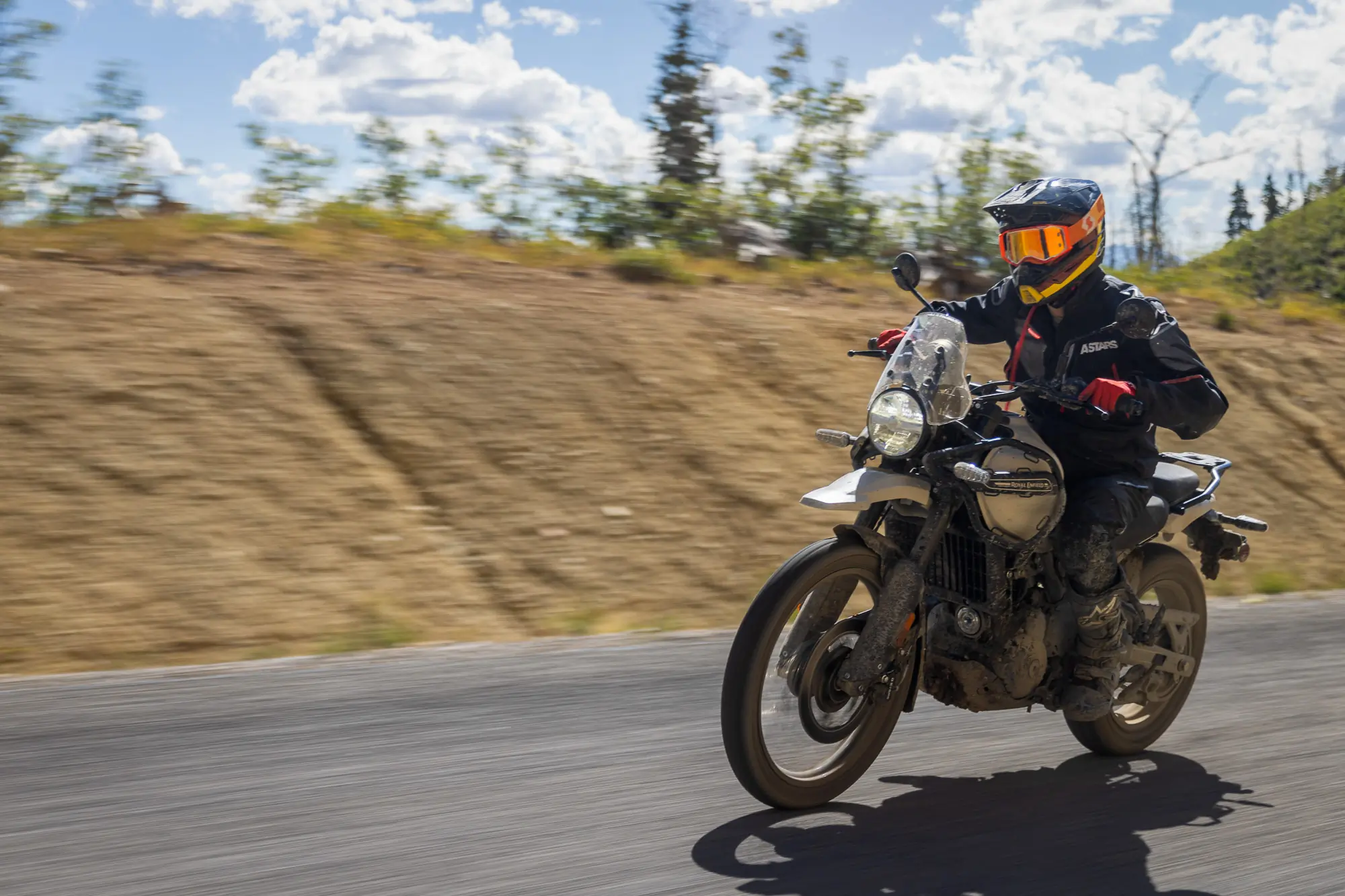
The original Himalayan severely lacked highway passing power, but I was pleasantly surprised by the new Sherpa motor’s road chops. The bike easily cruised at 75 mph as we rolled up on a tanker. I didn’t think the ride leader would pass the truck, seeing as our group was large, but away he went.
A downshift to fifth was necessary, but the Himalayan eagerly accelerated to 85 mph, and the pass was stress-free. I would later discover that with my 5’11” frame at 161 pounds, the bike topped out at 96 mph.
I found the revs built up slowly compared to 450cc motocross bikes and larger, twin-cylinder adventure bikes I’ve ridden. It felt as if the flywheel was heavy. This slow-to-rev engine character, even with generous use of the clutch, took a bit of getting used to. But within an hour, I noticed it much less. Also for a single-cylinder rig, the bike hummed along very smoothly.
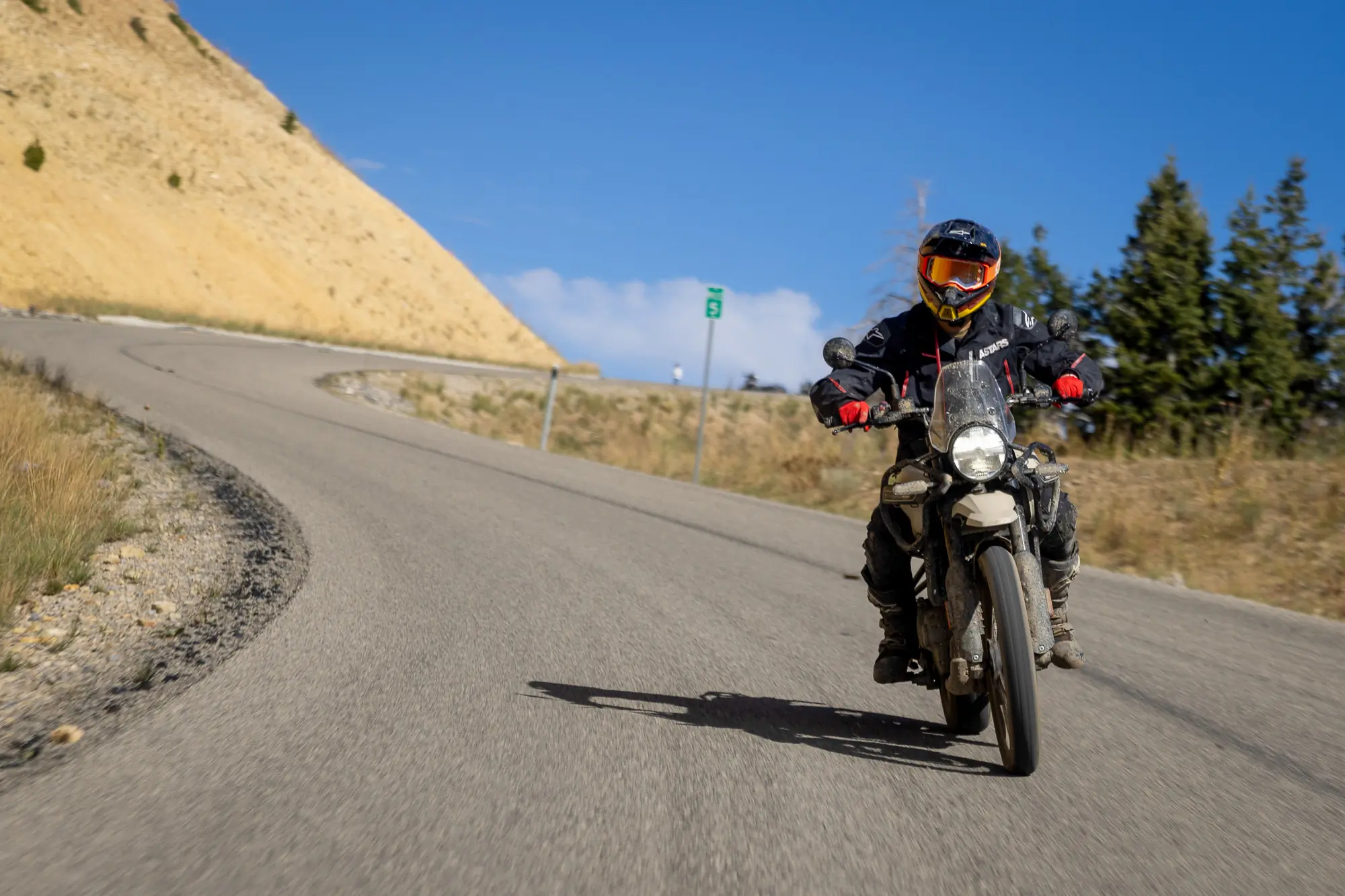



The suspension felt very planted in the portion of the stroke that it sat most of the time on roads. There was no appreciable diving or lurching on braking or accelerating. I’m not nearly as confident on the streets as I am on dirt.
On more dirt-oriented adventure bikes, I feel a bit sketchy due to suspension dynamics. Not so with the Royal Enfield Himalayan 450. I gained confidence with every mile, eventually hitting twisty sections as fast as I ever had.
On Dirt
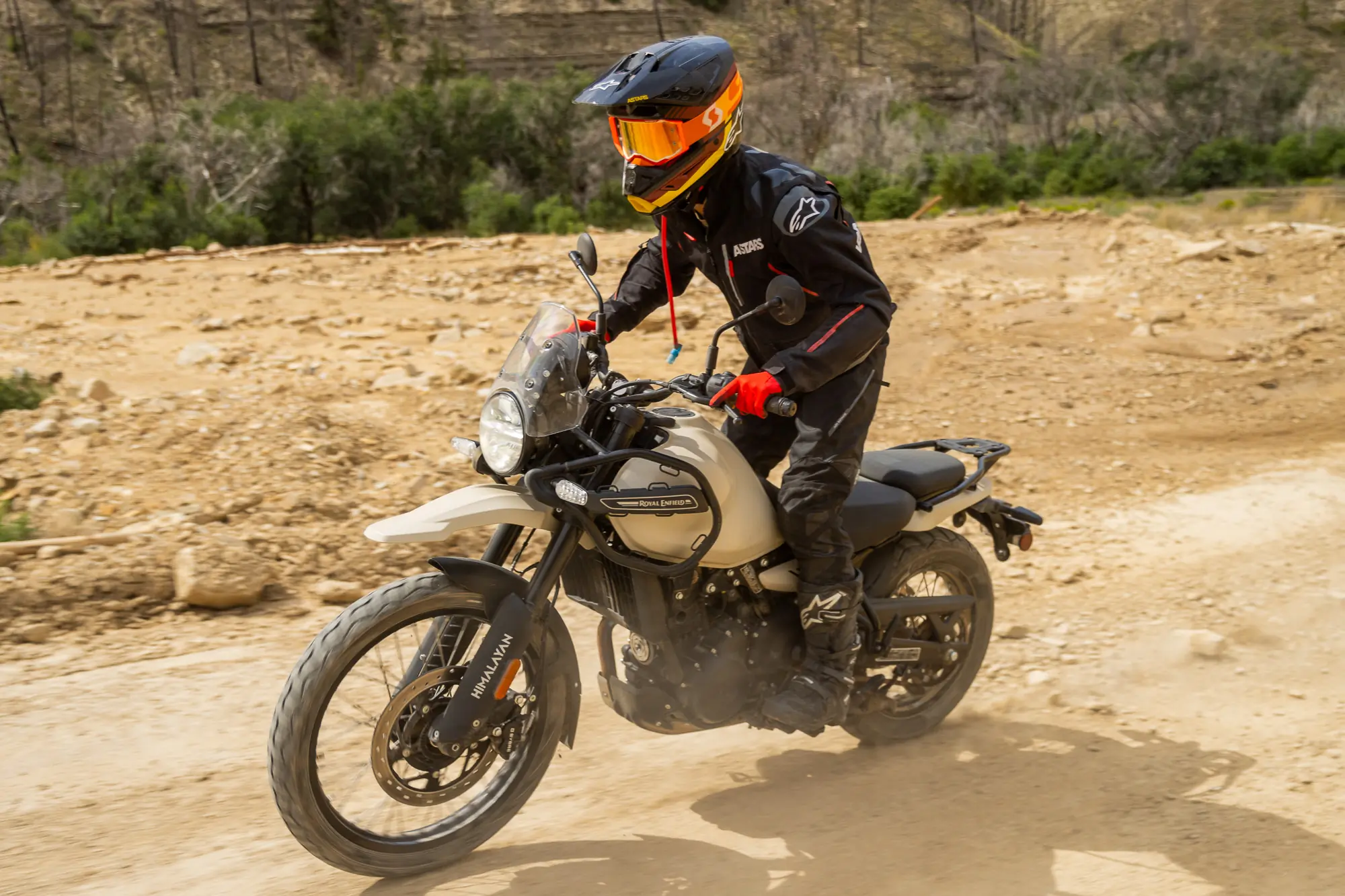



I didn’t have high hopes in the dirt based on past experiences with the original Himalayan and other inexpensive dual-sport models. But, again, I was surprised.
Suspension: Better Than Expected
Right away, on loose, dry, rock-strewn double track, I felt the front suspension was on point. The Showa Separate Fork Function (SFF) felt great at all speeds, even though they were not adjustable. I think I fall into the bell curve for rider weight, so that may explain a lot of it. But still, I’m used to playing with clickers, oil weight, oil height, and custom valving to get the right feel. The front end of the Himalayan felt comfortable, bone stock.
I felt the shock was acceptable. However, on some g-outs and faster square edges, I wished it had more spring rate, compression damping, and rebound damping. I didn’t stop to adjust the preload, but I would dial in a bit more, at the very least.
I hit an unseen lip with a blind landing in the middle of fourth gear. The fork was fine, but the rear kicked up violently, and I stayed on only because my heels clamped the frame just under the seat. The shock fully bottomed out, but the bottoming action wasn’t harsh; it was the rebound that got me.
Increasing the spring rate may have helped the shock hold up more, decreasing the amount of travel and related rebound. Incredibly, upon landing, the fork didn’t bottom out, which I expected.
Soon afterward, I unloaded the front to come out of a dip at high speed and got headshake. I kept the throttle opening consistent, and it righted itself quickly. It was unnerving, but the next one would have been much less so, knowing how it reacted.
Outside of these two instances, the suspension on the Royal Enfield served me well — remarkably so, considering the price.
Motor: Usable but Tame
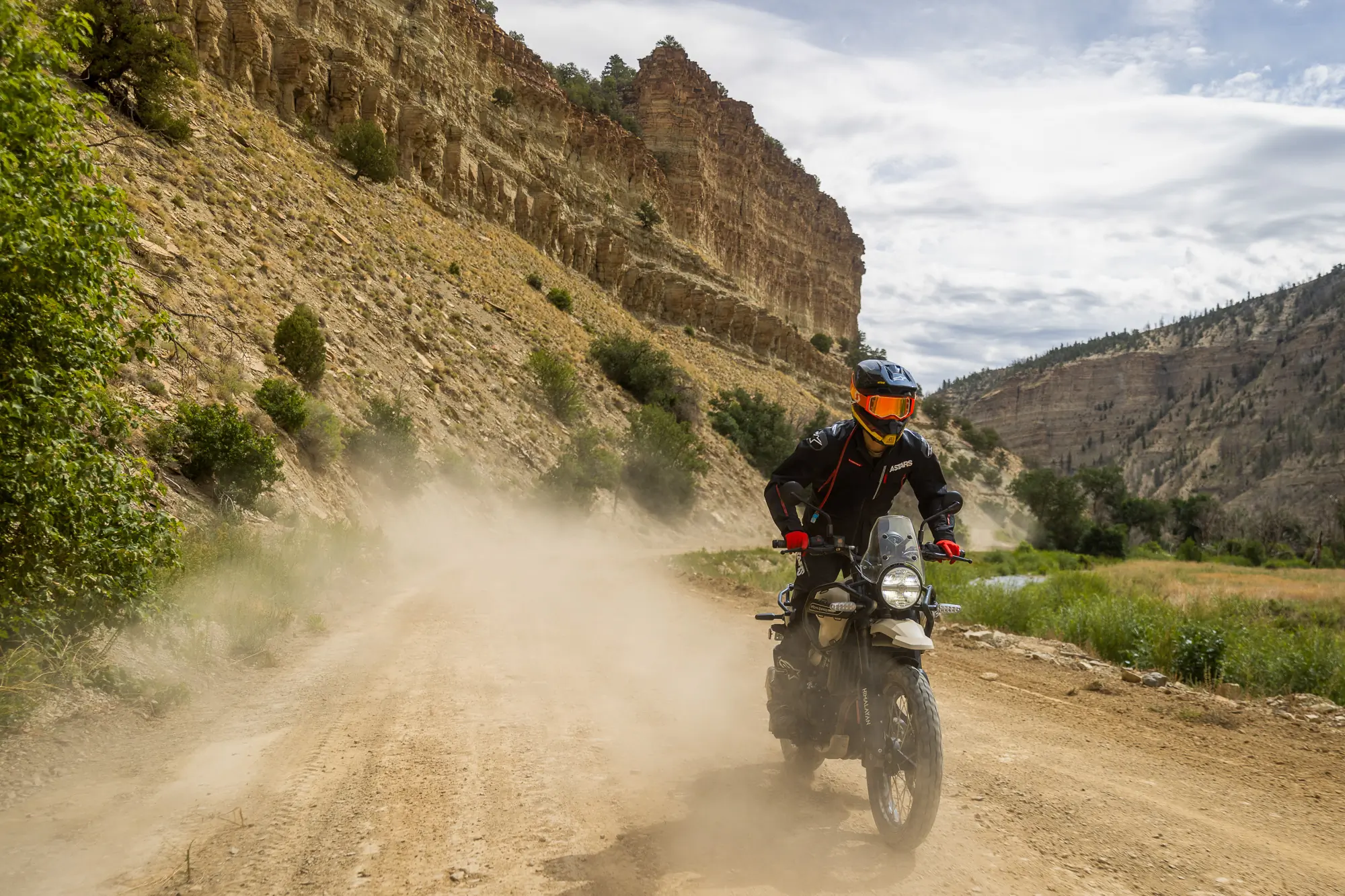



The slow-revving characteristic of the Sherpa motor, combined with the bike weight, was noticeable to me on the dirt much more than on the streets.
Even with plenty of clutch burning, I couldn’t use the power of the bike to unload the front that much. Manualing with the front wheel in the air was out of the question. Attempts to unload the front suspension and wheel required a lot muscling the bars and hanging my hips off the back.
Once I got used to it, this tame motor allowed me to relax more than usual during less aggressive dirt riding. The Royal Enfield Himalayan never got close to getting away from me, even when I was loose at the right wrist and legs. I could confidently override the bike, which is a great characteristic for beginners or those new to traveling on dirt.
ABS: I Left It On!
I have always turned the rear ABS off on any motorcycle when I get on dirt. I did the same on the Royal Enfield Himalayan 450 at first. But a slight double-wheel slide on marbles convinced me to turn it back on at the next stop. Amazingly, I left it on for the remainder of the day.
I have always despised how invasive rear-wheel ABS has been on all other adventure bikes. But the Royal Enfield system was minimally invasive. This was a first for me, so kudos to the development team!
Otherwise, the brakes were adequate and delivered all the stopping power I needed with the bike’s motor and suspension capabilities.
Caveats
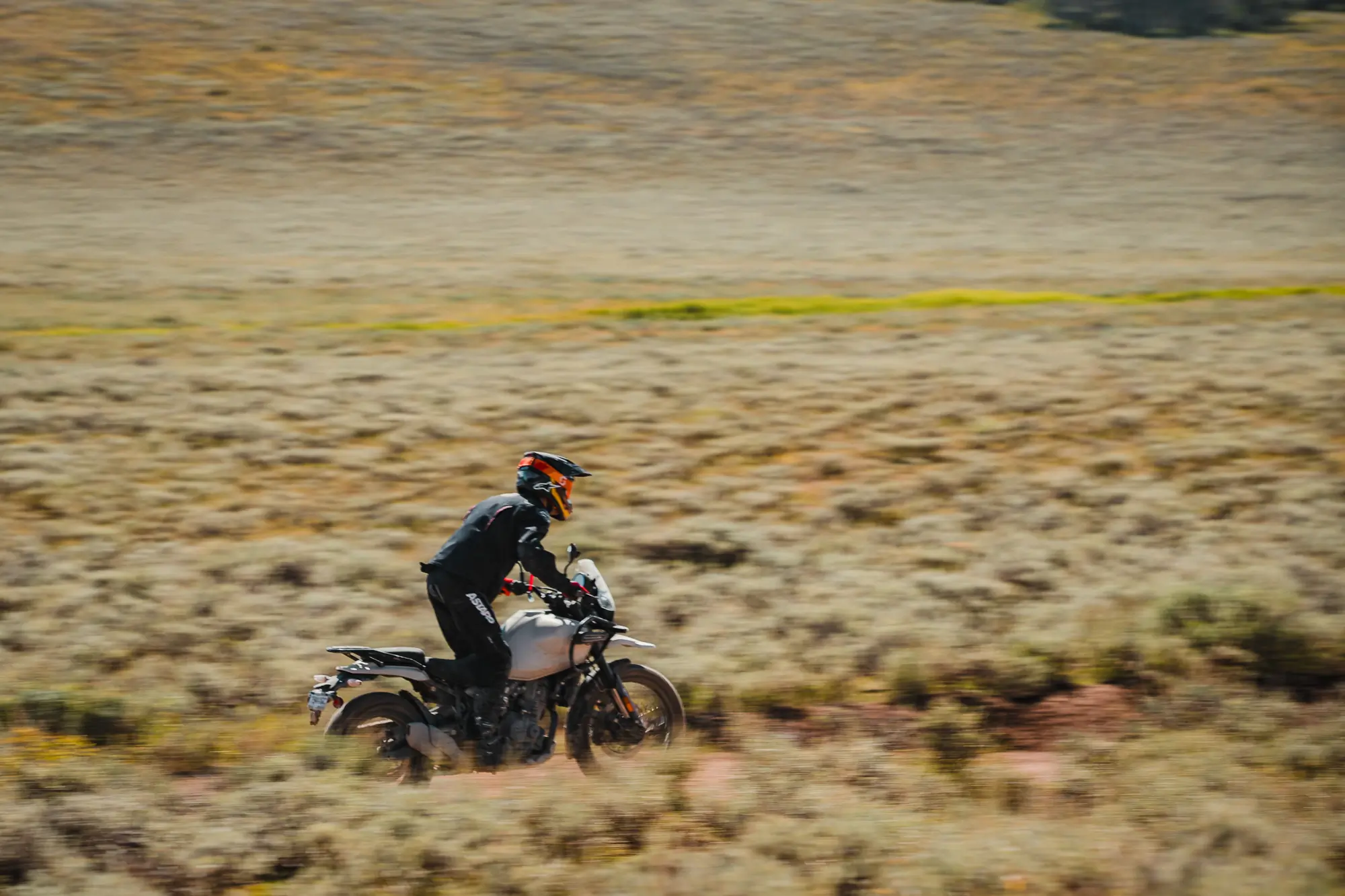



I discovered a few minor caveats during our journey up and down the ranges in Utah.
First off, the Royal Enfield Himalayan has an unusual double front fender. There is a “dirt bike” high front fender (really only the front half) and the usual tire-hugging fender many adventure bikes have in stock format. If I bought this bike, I would remove this low fender right away.
We hit a muddy section that stopped almost everyone due to a complete lack of traction. The dirt was a slippery as snot clay-based variety. The mud packed the tire grooves, and everyone was spinning and fishtailing while trying to duck waddle through the muck.
But in the middle of the quagmire, mud completely packed the space between the low fender and front wheel. My front wheel was solidly locked, unable to rotate, even with two of us trying to manually spin it.
The only solution was to remove the low fender. This was a simple affair with the included tool kit, only requiring turning six bolts. Luckily, the front brake hoses are not connected to this fender. This would be catastrophic if speeds were higher and the mud ripped the fender off. One rider did rip the fender off while riding, but it wasn’t a big deal.
Secondly, and I say this about every adventure motorcycle with grooved tires, I would replace the stock rubber with DOT-approved knobbies. This one step alone would catapult the Himalayan into a drastically better off-road machine.
Other Notes on the Royal Enfield Himalayan 450
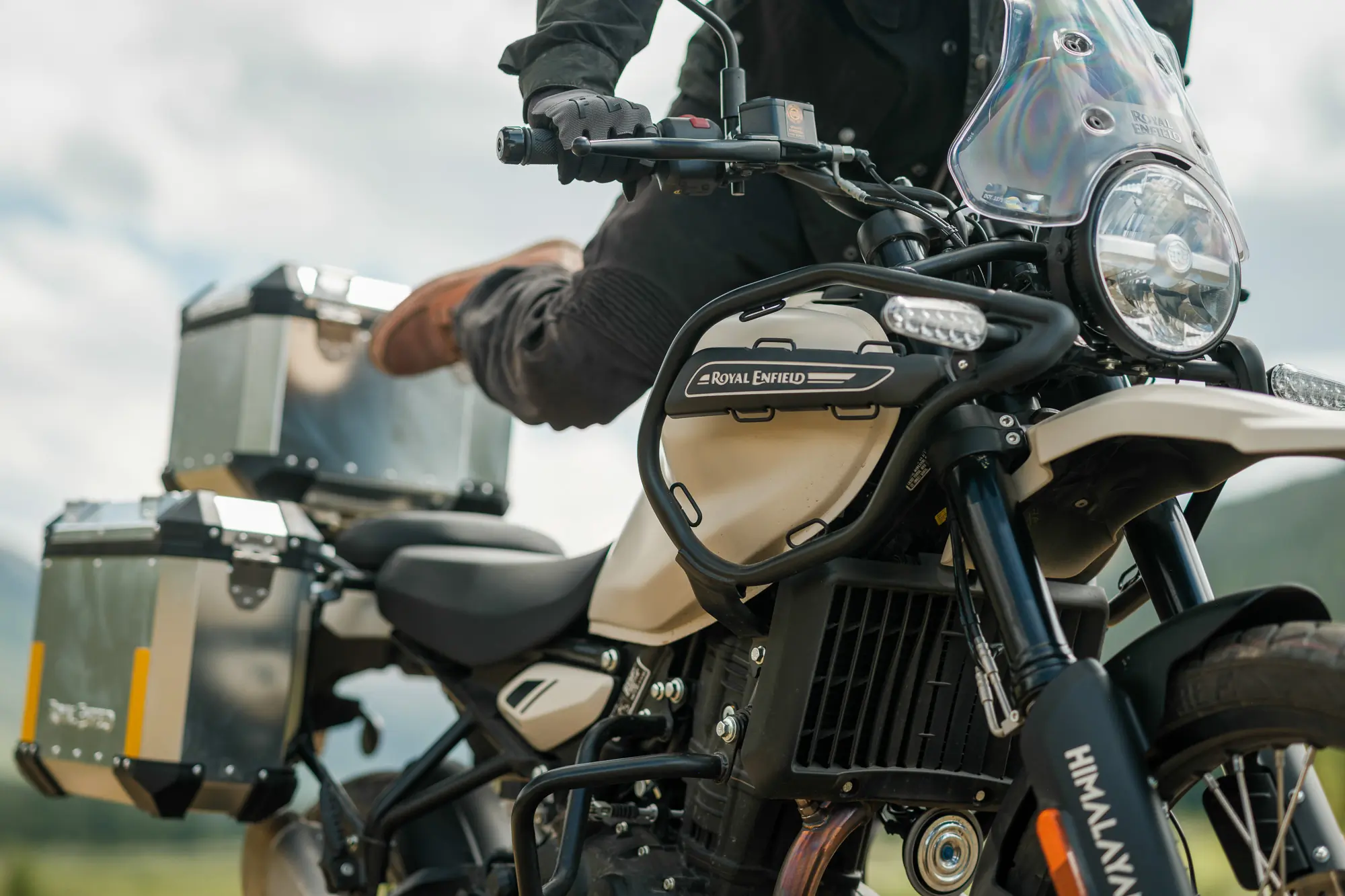



For a second run at an adventure bike, I felt Royal Enfield went above and beyond on so many things.
Ergonomics
The bike’s ergonomics were comfortable right away for my 5’11’ frame. For shorter pilots, Royal Enfield offers a lower seat. And for motocrossers, the brand has a moto-style seat that is continuous from front to rear. Also, the bar mounts can be flipped to move the bar forward from the stock position.
Crash Protection
The bike proved to be very crashworthy. I dropped my bike at a standstill in the mud when my front tire locked up, and it was fine. Then, I witnessed two riders go down in front of me, getting slammed pretty hard. Luckily, both riders were OK. T
0he bikes only required tweaking of mirrors, levers, and shift lever to be back on the trail. The tank’s crash guard worked well, and the other parts of the bike that hit the ground were undamaged.
Electronics
I also thought that the round TFT display was easy to read and very stylish. Because we were in a group, I didn’t refer to it much. But what I did notice was that all the vital bits of information were easily deciphered. And, as stated above, toggling the rear ABS on and off was so, so easy. And the setting stuck unless the key was removed. On other bikes, I’ve had to navigate through layers of menus, and repeat every time the motor was shut down.
Accessories
Royal Enfield showed us a touring and rally kit to accompany the Himalayan 450. The former included hard cases, including a top case that fits a helmet. The latter included the aforementioned motocross-style seat. All the bits I saw seemed to be of high quality, and the fitment, of course, should be on point. None of it seemed like cheap, overpriced afterthoughts, as can happen.
Lastly, everyone in attendance agreed that the Royal Enfield Himalayan 450 is an attractive, good-looking steed. It was unanimous.
Conclusions on the Royal Enfiled Himalayan 450
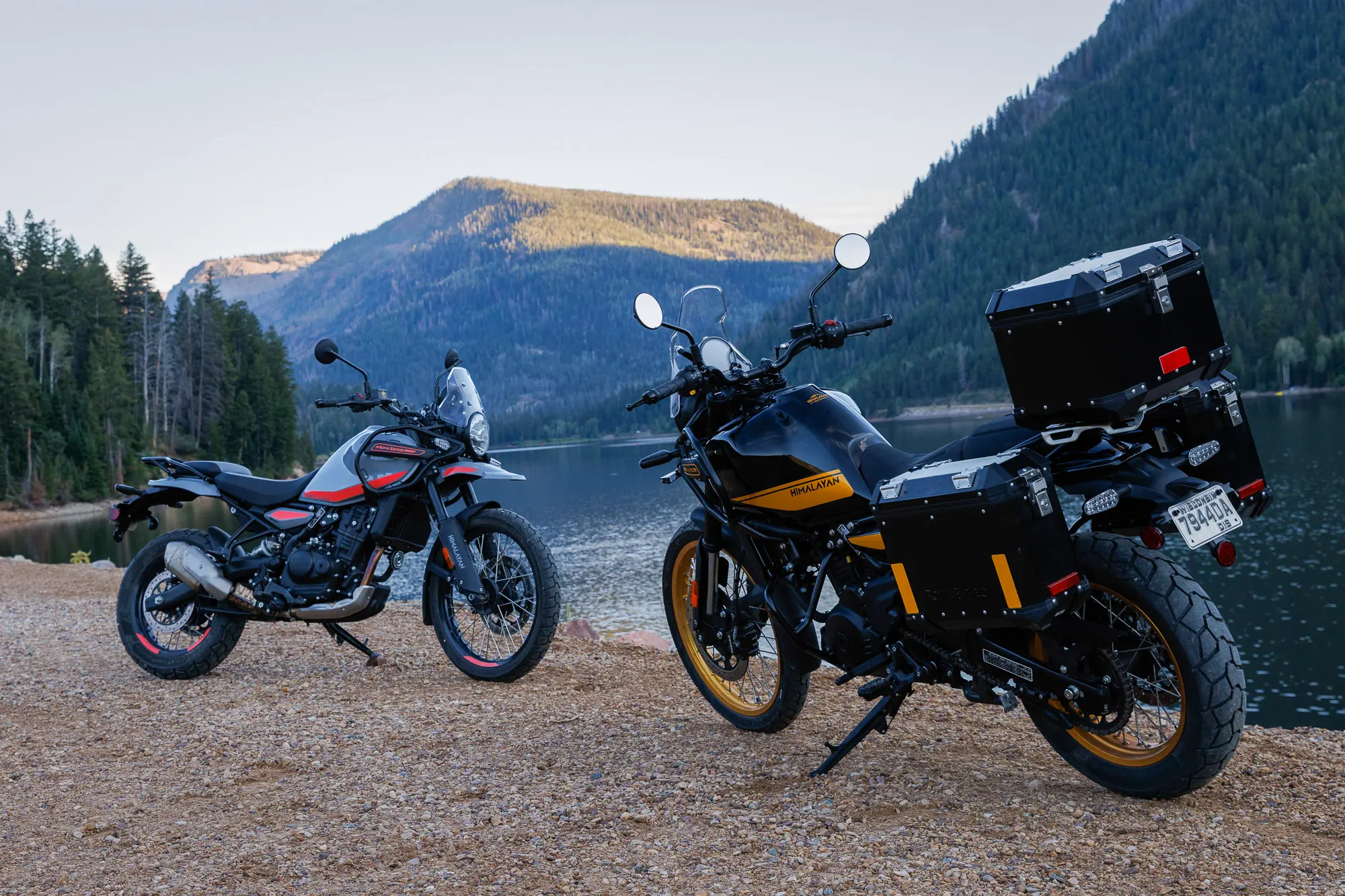



The Himalayan 450 proved to be a capable adventure bike both on and off-road. Sure, the motor wasn’t exciting, but it would be ideal for new riders or those venturing on dirt for the first time. The power delivery of the Sherpa powerplant would help a newer rider gain confidence on all surfaces. And ultimately, it got the job done: I had fun all day.
The suspension was incredibly well-mannered for a bike of this stature and cost, and the ergonomics were comfortable. And Royal Enfield can provide different seats tailored to different statures and riding styles. For a single-cylinder 450, the ride was smooth at all speeds and engine rpm.
The real kicker is the price. At a starting point of $5,799, I don’t think there is a better deal on the adventure bike market. It costs so much less than every other adventure bike I’ve ridden (other than the original Himalayan).
It also outperforms the inexpensive middleweight dual-sport bikes I’ve sampled by a large margin. As a Royal Enfiled presenter quipped, you can buy a high-end, big-bore adventure bike, and it will depreciate in value more than this bike costs in the first year.
Or, to put it another way, as the cycling editor at GearJunkie, my current test fleet doesn’t have a bicycle that costs less than the new Royal Enfield Himalayan. (Albeit they are all high-end bicycles, but still.)
